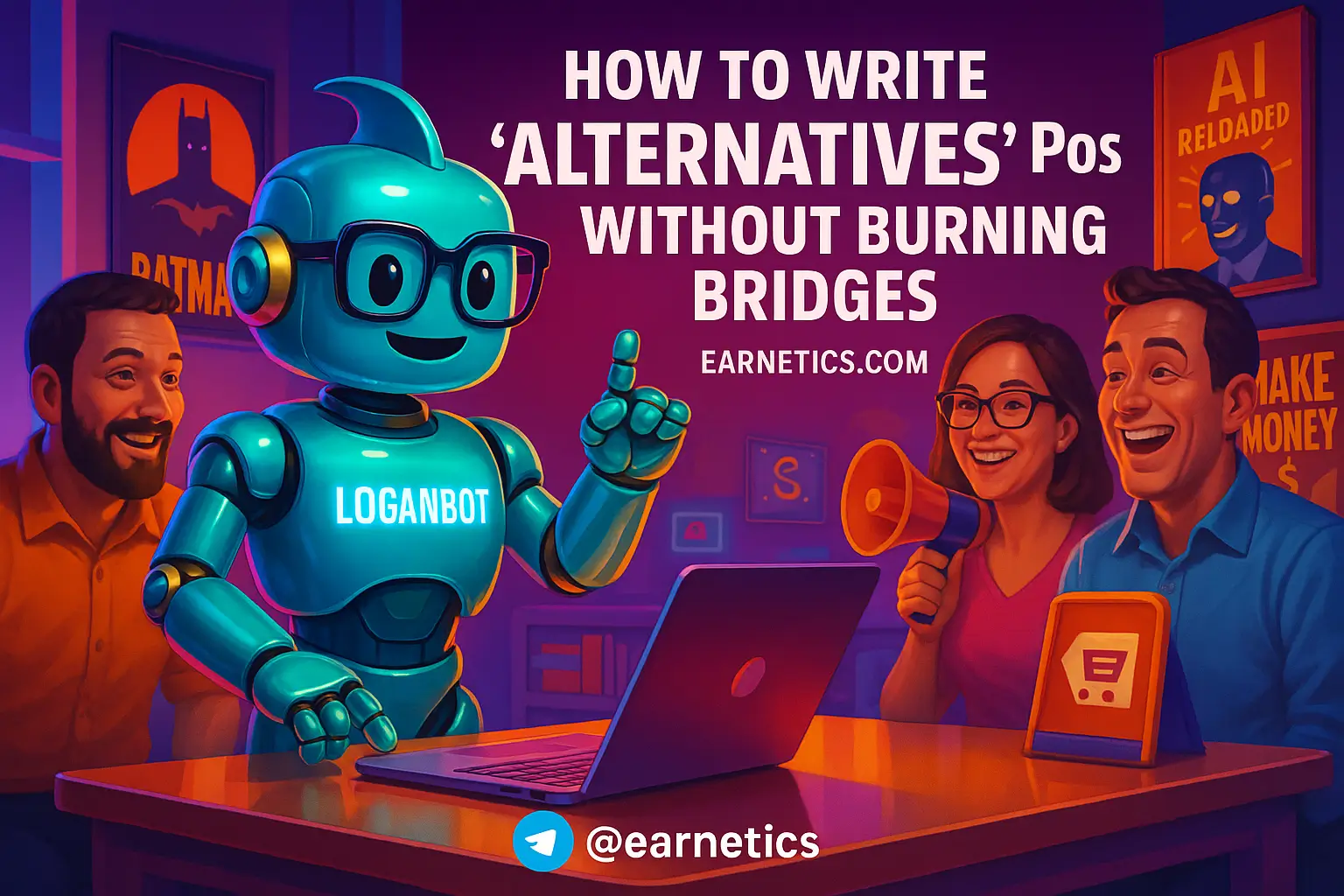How to Write Alternatives Posts That Recommend With Care and Rank
Want to recommend competitors without burning bridges? I show exactly how to write alternatives posts that are honest, SEO-friendly, relationship-safe, and tactful.
I’ve been the person stuck between a brand brief and an inbox full of partners who will read every word I publish, so I learned the hard way how to write alternatives posts that say what needs saying without starting corporate wars. This guide promises a repeatable, SEO-friendly process for writing alternatives posts that are honest, useful, and keep relationships intact.
Who this is for: bloggers, product marketers, affiliate writers, editorial teams, and community managers who need to recommend X alternatives without sounding like a jerky reviewer. I’ll walk you through five pillars: tone, structure, SEO, legal/disclosure, and outreach – the exact framework I now use when I craft comparison content that converts but doesn’t burn bridges.
Suggested primary title: How to Write Alternatives Posts Without Burning Bridges. Title variations: X Alternatives – How to Compare Without Alienating Competitors; Diplomatic Alternatives Posts That Rank.
Meta description concept (target intent: informational/comparison + trust-building): One-stop process for creating alternatives posts that answer search intent, keep partners happy, and pass legal checks.
Primary CTA I’ll return to at the end: a downloadable checklist and outreach email templates so you can hit publish with confidence.
Quick keyword research snapshot I ran while thinking about this: Primary keyword – how to write alternatives posts. Secondary keywords – neutral tone alternatives posts, alternatives post structure, alternatives post SEO, disclosure alternatives posts, outreach after alternatives post, X alternatives comparison. LSI and related terms – product alternatives, alternatives to X, X vs Y comparison, competitor comparison post, comparison post template, alternatives review, best alternatives list, comparison matrix, affiliate disclosure, neutral comparison language.
Neutral tone and constructive language
Frame as “better fit” not “better” – techniques to emphasize use-cases, audience fit, and scenarios instead of value judgments
I learned quick that telling someone their baby is ugly is a career-ender. So I stopped saying “this is better” and started saying “this fits if.” The trick is to frame comparisons around user needs and situational fit – price sensitivity, team size, feature depth, technical comfort. For example, instead of “Product A is better,” write “Product A fits teams that need heavy automation and are comfortable with code.” That’s specific and less likely to trigger defensive PR emails.
Every time I flip a feature into a fit statement the tone changes from judgmental to advisory. It also helps readers: people search for “X alternatives for freelancers” not “best X for everyone.” Target those intent nuances and you’re more helpful and less confrontational.
Language cheatsheet – hedging phrases, neutral comparatives, words to avoid and positive alternatives
Here’s the short cheat list I use before hitting publish: hedging phrases – “may be a better fit for,” “well suited to,” “ideal for”; neutral comparatives – “more focused on,” “offers stronger,” “leans toward”; words to avoid – “worst,” “scam,” “junk,” “garbage.” Swap those for “limited in,” “less suited for,” or “may not be ideal if.” I keep this cheatsheet open when editing so my copy sounds like a helper not a hatchet.
Mini takeaway: hedging is not cowardice – it’s savvy messaging that preserves relationships and helps search engines match the content to varied intent.
Use evidence and empathy – cite sources, user quotes, and acknowledge strengths of the compared product to reduce friction
I always pair my suggestions with evidence – benchmark figures, support response times, pricing tables, or a user quote. If Product B has an industry-first uptime SLA, I call that out even if I’m recommending Product C to startups. Acknowledging strengths builds writer credibility and gives readers nuance; it also makes vendors more likely to respond politely when you notify them.
When I can, I add a sentence that shows I get the vendor’s perspective – “If your team needs enterprise-grade security, Product B’s compliance stack is a major plus.” That tiny nod lowers heat and gives your critique context.
Structure and formatting for fair comparisons
Create a reproducible rubric – recommended criteria and how to weight them
I stopped winging comparisons once I built a rubric. My default criteria: price, core features, ease of use, support, integrations, and ideal customer profile. Then I decide weights by intent – for discovery posts price might be 20 percent and integrations 10 percent; for enterprise audiences security and support get heavier weighting.
Make your rubric visible to readers. I publish the criteria and weights at the top of the page so people know how I arrived at each verdict. That transparency makes it harder for companies to cry foul and easier for readers to judge if my priorities match theirs.
Templates for clarity – side-by-side tables, pros/cons bullets, and TL;DR verdict blocks for skimmers
People skim. I give skimmers a TL;DR box with one-line verdicts and a short persona match. Then I add a side-by-side table comparing price, standout features, and integrations. Below that I use pros/cons bullets and one or two user quotes. Templates like this speed up writing and make comparisons repeatable.
Mini how-to: create a single HTML block or page section you reuse – copy, update scores, and tweak the verdict. It keeps your site consistent and your readers happy.
Match alternatives to user personas – quick mapping of which alternative fits which audience/problem
Map each product to 2-3 personas: freelancer, SMB, enterprise, budget-conscious, non-technical, power-user. I include a one-line “Best for” under each product name. When readers find their persona, they find their answer fast. That easy mapping reduces comment friction and sharpens calls to action because you can use persona-specific next steps.
SEO tactics for alternatives posts
Keyword strategy and intent mapping – long-tail “X alternatives”, “X vs Y”, and search intent variations
SEO for alternatives posts is not just about stuffing keywords – it’s about mapping intent. I build keyword groups: research intent (“X alternatives”, “alternatives to X”), comparison intent (“X vs Y”), and transactional intent (“best X alternatives for small business”). I use long-tail variations to capture different stages of the funnel. For each cluster I create a target URL or anchor within the page so Google has clear signals.
Practical tip: use question modifiers – “X alternatives for freelance designers” – to pick up featured snippets and niche traffic.
On-page optimization – H1/H2 hierarchy, schema for product reviews/comparisons, comparison tables, FAQs to capture snippets
I structure pages with a clear H1, followed by H2s for each main section, and H3s for subtopics. I add Product Review schema or Comparison schema where relevant so search engines can understand the content type. Comparison tables and a robust FAQ section are prime real estate for snippets – answer common queries in short, direct sentences that can be lifted by search engines.
When I add schema I validate it with Google’s Rich Results test and iterate. Small effort, big visibility gains.
Internal/external linking strategy – link to original vendor pages tactfully, related content, and avoid keyword cannibalization
I always link to vendor pages when I mention features or pricing – it’s fair and useful to readers. The trick is to use neutral anchor text like “vendor pricing page” or “official docs” rather than “buy here.” I also link to related deep-dives on my own site to keep users moving down the funnel. To prevent keyword cannibalization I map target keywords across my site and pick one canonical page for “X alternatives” queries.
Mini-action: add UTM parameters to outbound affiliate links so you can track which comparisons drive clicks without sounding spammy in the anchor text.
Legal, ethical, and disclosure best practices
Fact-checking and avoiding defamation – simple verification steps, how to document claims, when to quote sources
I learned to treat claims like legal questions. Before publishing, I confirm specs on vendor sites, check screenshots against live UIs, and keep a timestamped record of where I got numbers. When I make a claim that could be sensitive – like “slow support response” – I back it up with data, user quotes, or a link to a public forum discussion. If I’m quoting a user, I ask permission or make the quote anonymous.
When in doubt, rephrase. Be factual, not accusatory. If a claim is borderline, I either omit it or present it as a reported issue with attribution.
Affiliate links, sponsorships, and transparency – recommended disclosure language and placement that keeps trust intact
Disclose early and plainly. My go-to line at the top of comparison posts: “This post contains affiliate links. I may earn a commission at no extra cost to you.” Put it above the fold so readers and regulators see it first. I also repeat the disclosure before any purchase CTA and include a fuller disclosure in a footer if needed.
For more formal guidance on endorsements and disclosures, I reference FTC guidance to stay on the safe side – it’s the same playbook most reputable publishers use. FTC: Endorsement Guides
Trademark and brand name usage – fair use tips, neutral screenshots, and when to seek permission
Use trademarked names when necessary to be clear, but avoid logos in a way that implies endorsement. I use neutral screenshots cropped to show features, and I avoid copying brand assets verbatim. If you plan to use logos prominently or reproduce marketing materials, ask permission – it’s faster than a cease-and-desist and keeps doors open.
Mini rule: when in doubt, ask. It’s cheaper than a PR headache.
Outreach and relationship management
Tactful notification templates – what to say when you notify companies you mentioned
I always notify companies I mention – not as a warning but as a courtesy. My go-to template is short and friendly: a quick intro, a link to the post, one line on the angle, and an offer to make corrections or add a quote. Keep it non-defensive: “Hi, I wanted to share this comparison we published that includes Product X. Happy to clarify anything or include a short statement from your team.” The tone matters more than the content.
Companies often reply with praise, minor corrections, or a quote – and that’s a win. I’ve had vendors promote the piece themselves after a simple heads-up.
Invite feedback and corrections – how to make updates, publicly acknowledge input, and use corrections as relationship-building opportunities
When a vendor sends new info or a correction, I update the post and add a short note: “Updated on [date] with input from [company].” Publicly acknowledging input is low-cost diplomacy that builds trust. If someone offers a correction that changes scoring, I rerun the rubric and note the change – readers see the edit trail, and vendors see you’re fair.
This approach turns potential critics into collaborators over time.
Turning neutral mentions into partnerships – pitch ideas for co-marketing, case studies, or expert quotes without appearing transactional
Neutral mentions can become partnerships if you pivot thoughtfully. After notifying a vendor, I might suggest a co-marketing angle – a joint webinar about use-cases, a customer case study, or an expert quote to add depth to the story. Offer value first: propose measurable outcomes like leads or shared promotion. Keep the ask small at first – a 20-minute quote call is more likely to get a yes than a full-blown sponsorship pitch.
Mini challenge: after three neutral notifications in a row, offer one low-commitment co-marketing idea. You’ll be surprised how many say yes.
Conclusion
I’ve covered five core approaches that keep alternatives posts honest, useful, and relationship-friendly. Tone matters – frame suggestions as fit not judgment. Structure matters – use reproducible rubrics, TL;DR verdicts, and persona mapping. SEO matters – target long-tail intent, use schema, and build FAQ snippets. Legal and disclosure practices matter – fact-check, disclose early, and use neutral brand usage. Outreach matters – notify, accept corrections, and use neutral mentions to open partnership doors.
Here’s a copy-ready checklist you can run through before you publish: tone checklist – use hedging phrases, acknowledge strengths, avoid loaded words; structural checklist – include rubric, TL;DR, and persona mapping; SEO checklist – target “X alternatives” long-tails, add schema, and include FAQ; legal checklist – verify claims, add disclosure, document sources; outreach checklist – send a friendly notification, invite a quote, log responses.
Measure and iterate: track engagement metrics (time on page, scroll depth), referral traffic to vendor pages, and outreach responses. If a competitor replies with corrections or a quote, note how that affected clicks or shares. I normally run one small test per quarter – tweak the rubric weight or FAQ phrasing – and watch for ranking shifts.
If you want to skip the guesswork, grab my downloadable checklist and outreach templates at the link below so you publish faster and safer. They’re the same tools I use when I’m under a deadline and don’t want to start another inbox feud.
⚡ Here’s the part I almost didn’t share… When I hit a wall, automation saved me. My hidden weapon is Make.com – and you get an exclusive 1-month Pro for free.
✨ Want the real secret? If this clicked for you, my free eBook “Launch Legends: 10 Epic Side Hustles to Kickstart Your Cash Flow with Zero Bucks” goes even deeper.
Ready to stop guessing and start publishing alternatives posts that actually help people and preserve partnerships? Explore more guides on Earnetics.com and download the checklist to publish with confidence.


